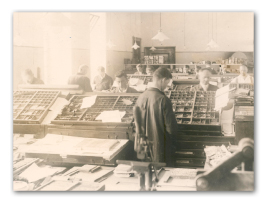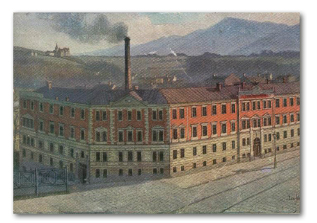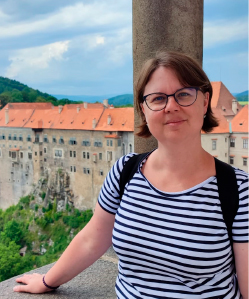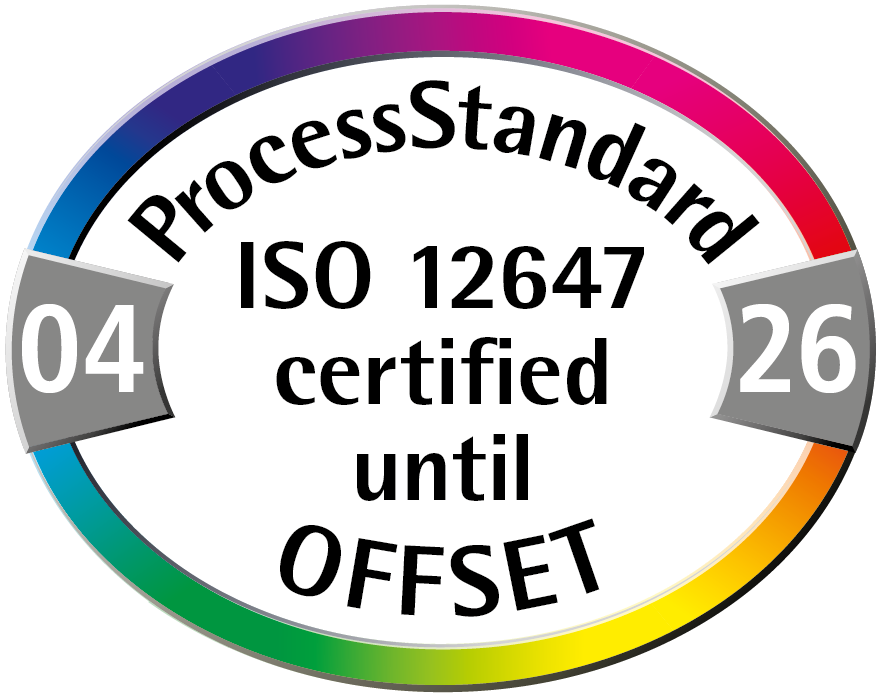Text: Pavlína Badurová
Tomáš Václav Antonín Prochaska owned the printing house until his death in 1817. As we can read in the contemporary press, his brave, sensitive and refined wife Anna Marie stood by his side all the time. After her husband’s death, she successfully ran the company for nearly ten more years and increased the company’s assets thanks to her skill.

As mentioned, the family took turns running the company for the next four generations. For historians and enthusiasts of the history of printing in Těšín, the situation was complicated by the fact that all four successive owners of the company were named Karel. (For the sake of clarity, they are referred to by the numerals I-IV, although they were not actually officially referred to as such.)
In 1826, Tomas’ first-born son Karel (I.) Prochaska (*1806, +1857) took over the business, but soon had to give up the management of the company due to illness. Now it was again a woman, Karl’s wife Anna, who took over the scepter. An extremely business-savvy, highly educated and hard-working lady, she managed the shop and the printing house with prudence until the death of her husband and on until their joint son Karel (II) Albin finished his studies. In the first decades, the printery produced only for Těšín and its immediate surroundings, the most common products were the so-called cram prints, hymn books, prayer books, dictionaries and circulars. However, the first history of the Principality of Teschen, Versuch über die Geschichte des Herzogthumes Teschen: von den ältesten bis auf gegenwärtige Zeiten, written by Albin Heinrich in 1818, also saw the light of day here. The current technical equipment and staff only allow printing in small quantities.
The early 19th century was not a time that was kind to women. Girls could already go to a trivial school to learn the three basic skills of reading, writing and arithmetic, but that was the end of their education. It was still not very fitting for a woman to boast of her knowledge. We can only imagine the courage it must have taken, the effort it must have taken, and the prejudices that women who were gifted in any way had to overcome. Perhaps just by continuing the business they had started with their husbands.
In 1850 Karel (II.) Albin Prochaska (*3.10.1829 Těšín, +26.5.1906 Těšín) became the head of the company. After graduating from the Catholic grammar school in Těšín, he trained as a lithographer and bookseller in Vienna. After his return, together with his mother Anna, he took part in the management of the company. In 1863 he became its sole owner. He is the person under whose leadership the factory achieved its greatest growth and became known not only within the Austro-Hungarian Empire, but throughout Europe. With his person comes the most productive period of Prochaska’s printing house, in which thousands of books were printed.
One of the first business ventures was the establishment of a branch in Bílsko sometime between 1848 and 1850, which operated until the 1860s. The name of the company was also changed to Karl Prochaska’s Buchdruckereien in Teschen & Bielitz (Prochaska’s printing works in Teschen and Bielitz).

In May 1850 the Prochasks bought Wäscher’s bookshop in Těšín on the “Market Square”. It was one of the first ever bookstores operating in the town. In those days, bookshops did not only sell books. Art objects and music books were available. Around 1860, the business expanded to include a publishing house, and in November 1865, a book lending house. They owned the premises, located even from today’s perspective in a very lucrative location in the city centre, until 1903.
As for the investment in the actual operation of the printing plant – the number of workers did increase to six to ten, but it was still only hand-driven. The first indication of the changes to come was the installation of the first high-speed press by Heinrich Löser of Vienna in 1857 and another by König & Bauer in 1863. In 1866, steam power was introduced into production, while the machine park was expanded. In 1874 the lithography department was put into operation, later chromolithography. At the beginning of the 1870s, bookbinding was added as another department in the printing house. As of 1876, we have records of 136 men and 82 women working in the company.
The printing house was no longer limited to local orders, but was able to provide them throughout the entire Austro-Hungarian Empire. It was during this period that the company enjoyed a great reputation in many of the bookbinding centres of Europe. Books were printed here by publishers from Vienna, Dresden, Leipzig, Paris, Budapest, Warsaw, Berlin, Bratislava, etc. Books are published here in many world languages.
Countless works of beautiful literature were published, e.g. in 1873 Prochaska published all six volumes of Goethe, but also works by Balzac, Dumas, Schiller, Scott, works by German classics, novels of world literature, etc. He also published a series of inexpensive books; well-known are his maps of the railways of Austria-Hungary and Europe, maps of Austria-Hungary, a transport map of Bohemia, Moravia and Silesia, a history of the Austro-Hungarian railways, a list of postal, railway, telegraph, telephone and steamship stations in Austria-Hungary. Historical and natural science works, books on medicine and pharmacology, biographies and, last but not least, military literature. It may be interesting to note that Prochaska printed the Koran in his company.
Literature for the C.K. army began to be published and a bookstore of military literature was established. In order to better distribute its products, the company set up publishing bookshops in Vienna and Leipzig, i.e., branches of its company. This meant that they were not only able to sell books from other printers at a profit, but also to focus on their own publishing activities.
Karel (II.) Albin was honoured for his merits more than once. In 1876, Emperor Franz Joseph I awarded him the gold medal “litteris et artibus” and the Knight’s Cross of the Order of Franz Joseph.
In 1883, the printing house was promoted to an imperial-royal supply company and began to use the name: Kaiserliche und königliche Hofbuchdruckerei und Verlagshaus Carl Prochaska – along with the new name, it used the double-headed gilded imperial eagle as the emblem of this award on the building’s gable. This prestigious award meant that the Prochaskas could supply goods or services to the Imperial Court in Vienna. This title was the highest possible award a company could achieve and was only bestowed on the best manufacturers or entrepreneurs in their field. It also represented a guarantee of authenticity and the highest quality.
Karel (II) Albin Prochaska was an active participant in public life in Těšín – he was a member of local institutions and a member of the town council. In 1904 the town of Těšín granted him honorary citizenship. His employees founded the singing group “Typographia” and the charitable association “Die Gutenberger”.
In 1881, Karel (III.) Prochaska (*21.1.1856 Těšín, +28.1.1920 Těšín) took over from his father the independent management of the technical part of the printing house and thus significantly contributed to the rise of the family business. Like his father, he graduated from the Catholic grammar school in Těšín and then completed his university studies in Vienna. He acquired practical printing skills at the State Printing House in Vienna and at a printing house in Leipzig and a bookshop in Bonn.

In the late 1880s, one of the largest investments in the development of the company was made. The investment involved the construction of a new building for the printing house. During the years 1886-1888, a new modern three-storey printing plant was built on the Saská kupa (Hlavní třída, Český Těšín), to which a rear wing and a side wing situated on the embankment of the Olza River were added in two construction phases in the following years (1892 and 1909/1910).
The development of the plant continued successfully – in 1894 the first stereotype in the Czech lands was to be set up in the plant. The number of employees increased from 300 in 1894 to 325 in 1900. The printing house presented its products with great success at a number of foreign exhibitions – in 1872 at the World Exhibition in London, in 1881 in Venice and in 1900 in Paris.
On 26 May 1906 Karel (II) Albin died. The report published in the June issue of the Silesia newspaper testifies to the remarkable position he held in public life. His funeral was attended by many prominent persons, including Archduke Albrecht, municipal councillors headed by the mayor of the town Dr. Demel, members of the state authorities, presidents of the chambers of commerce from Vienna, Prague and Opava, industrialists, members of associations and corporations of booksellers and printers and many others.
In the obituaries, we find words like a distinctive and courageous businessman, a soulful man, a conscious investor and not a petty speculator, a man of great insight, a sincere, sympathetic and energetic personality, always elegant with tremendous work ethic, a stubborn man, pursuing his goal without looking back at obstacles. Thus, we cannot but admit that he was a typical, tough businessman of his time, fighting the competition for his own profit by various means. In his report to the offices in Vienna and Leipzig, he writes that measures such as the use of cheap labour, i.e. the employment of women, helped his company to flourish.
Karel (II) Albin handed over a huge estate to his son, of which he became the sole owner in 1907. Karel (III) Prochaska (*21.1.1856 Těšín, +28.1.1920 Těšín) inherited the company (Karl Prochaska, k.u.k. Hofbuchdruckerei und Verlagsbuchhandlung, Teschen) in full bloom – he also managed to follow in his father’s footsteps at first.
Around 1900, a type foundry and electroplating were established, and chromolithography was expanded over time. The printing house did not cast its own cuts of fonts designed by famous typographers, but purchased original fonts from other parts of the monarchy with the right to cast them. Special departments of the printing house included a notary and a typesetting room, which also had equipment for typesetting Cyrillic text.
The printing house had a large bindery, which enabled the complete production of books in a so-called closed cycle – from commissioning the manuscript, through typesetting, printing and binding – all in one plant. It was also financially advantageous for the publishing house to concentrate all the processes in one place. The binding capacity for 1913 was 1,500,000 copies. In 1914, 400 workers and clerks were already employed in the printing house. In 1914, the printing house successfully exhibited at the International Exhibition of Printing and Graphic Arts in Leipzig.
The production of periodicals in the printing house in Těšín was also considerable. For example, from 1848 the first Polish newspaper of Austrian Silesia and the first ever newspaper published in Těšín, Tygodnik Cieszyński (renamed Gwiazdka Cieszyńska in 1851) were published. In 1857 the Kalendarz cieszyński began to be published. From 1860 the Schlesischer Anzeiger (from 1862 under the title Silesia) was printed here. It was published by Karel Prochaska, who was also the editor from 1860-1878. In 1894, the newspaper Těšínské noviny, edited by Blandina Čížková, began to be printed.
Prochaska’s illustrated library – Prochaska’s family calendar and illustrated newspapers (Prochaska’s Familien Kalender, Prochaska’s illustrierte Monatsbläter) were very popular.
At the outbreak of the First World War (1914-1918), the operation of the printing house was greatly reduced and a period of stagnation set in. The production of publications and books for the needs of the c.k. army helped the company considerably at first. However, with the end of the war and the disintegration of the Austro-Hungarian monarchy came the decline. In 1918-1920, Těšín was caught up in a dispute between the successor states Czechoslovakia and Poland. The dispute was not resolved until July 1920, when the hitherto integral territory of the Principality of Teschen was divided. The administrative centre of the territory, the town of Těšín, was also divided, with the Olza River forming the boundary. The left-bank part of the original Těšín, the Saská kupa and Kamenec, together with the settlement of Brandýs, fell to the newly established Czechoslovakia. The new young town of Český Těšín was created from the original industrial suburbs. Due to the changed political situation in Europe, Prochaska’s printing house lost its German and a large part of its foreign clientele. Within the newly established Czechoslovak Republic, the company had a hard time finding clients.
In these politically and commercially turbulent times, another blow is coming for the company. In January 1920, the owner of the company, Karel (III) Prochaska, died shortly after his 64th birthday. In 1921, the last of the family, Karel (IV) Prochaska (*19 February 1886 Těšín, +2 April 1948 Forchheim) took over the management of the company and tried to guide it through the difficult period. He continues in the footsteps of his ancestors – he puts money into new machinery, tries to keep up with new technical and technological procedures. It improves and invests. At the same time, hand in hand with the reduction in profits, it is taking on more and more debt. In 1925 offset printing was introduced, and in 1931 the first Linotype typesetting machines were installed. In an attempt to increase the production of the printing house during the economic crisis, Karel (IV) started printing exclusive, richly illustrated pornographic publications “Hexenkessel der Liebe” for German customers. However, several thousand copies of these prints were confiscated and the company suffered considerable financial losses. As a result of the economic crisis, on 1 January 1930 the company was transformed into a limited liability company called ‘Knihtiskárna a nakladatelství Karel Prochaska’. Even after the transformation of the company into a joint-stock company, sales continued to decline and the number of employees fell to 194 by 1934. In 1936, the company was transferred to the Central Bank of German Savings Banks (Zentralbank) based in Prague through the Krnov Savings Bank. After the bankruptcy of the Zentralbank in 1937, the company came under the administration of the government.
At the end of the interwar period and in the first year of the Second World War, the printing house was hardly in operation at all. On 29 October 1940, Hubert Lüdemann, a Reich German, and his wife Adelaide bought the printing house. He took over the business on 16 December 1940 and owned it until May 1945.
In the next issue of Finidrak you can look forward to the continuation entitled: there are never enough printeries – Feitzinger and Kutzer.

Pavlína Badurová
I was born in Český Těšín and I studied history at the Silesian University in Opava. Since 2002 I have been working in the Museum of Těšín Region, initially as a historian and curator of collections, and currently as the head of the Historical Building of the Museum of Těšín Region in Český Těšín.
My parents worked in a printing house. I am sure it stems from them – love and respect for books, fascination with the process of book production. As children, my brothers and I were very lucky and sometimes we were able to look “under the hood” of the printing house. I still remember it – the impressions, the sounds, the smells.
Through my studies and employment, I got into regional history. Prochaska’s printery is simply a heartbreaker!






